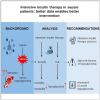Intensive insulin therapy in sepsis patients: Better data enables better intervention
- PMID: 36915524
- PMCID: PMC10006498
- DOI: 10.1016/j.heliyon.2023.e14063
Intensive insulin therapy in sepsis patients: Better data enables better intervention
Abstract
In clinics, sepsis is a critical disease that often develops into shock and multiple organ dysfunction, leading to a serious threat of death. Patients with sepsis are often accompanied by stress hyperglycemia which is an independent risk factor for poor prognosis in sepsis. Thus, the treatment for stress hyperglycemia has attracted more and more attention, among which intensive insulin therapy is widely concerned. However, the benefits and harms of intensive insulin therapy for sepsis patients remain controversial. What the existing literature discusses mostly are the clinical benefit and hypoglycemia risk of intensive insulin therapy, but there is no conclusion on the target range of blood glucose control, the applicable patients, the timing of treatment initiation, and how to avoid the risk. In this study, we have analyzed and summarized the existing literature, hoping to determine the adverse and clinical benefit of intensive insulin therapy in sepsis. And we attempt to assemble better evidence to propose a better recommendation on hyperglycemia intervention for sepsis patients.
Keywords: Benefit; Intensive insulin therapy; Risk; Sepsis; Stress hyperglycemia.
© 2023 The Authors.
Conflict of interest statement
The authors declare no competing interests.
Figures



Similar articles
-
Glucose metabolism and insulin resistance in sepsis.Curr Pharm Des. 2008;14(19):1887-99. doi: 10.2174/138161208784980563. Curr Pharm Des. 2008. PMID: 18691100 Review.
-
Glucose control in the intensive care unit.Crit Care Med. 2009 May;37(5):1769-76. doi: 10.1097/CCM.0b013e3181a19ceb. Crit Care Med. 2009. PMID: 19325461 Review.
-
Sepsis Care Pathway 2019.Qatar Med J. 2019 Nov 7;2019(2):4. doi: 10.5339/qmj.2019.qccc.4. eCollection 2019. Qatar Med J. 2019. PMID: 31763206 Free PMC article.
-
Intensive insulin therapy and pentastarch resuscitation in severe sepsis.N Engl J Med. 2008 Jan 10;358(2):125-39. doi: 10.1056/NEJMoa070716. N Engl J Med. 2008. PMID: 18184958 Clinical Trial.
-
[Influence and mechanism of a tight control of blood glucose by intensive insulin therapy on human sepsis].Zhonghua Wai Ke Za Zhi. 2005 Jan 1;43(1):29-32. Zhonghua Wai Ke Za Zhi. 2005. PMID: 15774170 Clinical Trial. Chinese.
Cited by
-
A retrospective study utilized MIMIC-IV database to explore the potential association between triglyceride-glucose index and mortality in critically ill patients with sepsis.Sci Rep. 2024 Oct 15;14(1):24081. doi: 10.1038/s41598-024-75050-8. Sci Rep. 2024. PMID: 39402158 Free PMC article.
References
Publication types
LinkOut - more resources
Full Text Sources

